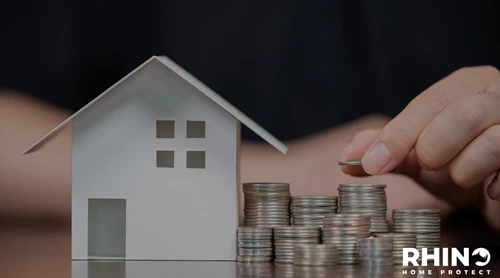Buying a new build home vs buying an old one: which is better?
When it comes to the perfect home, every buyer is different.
Some people dream of a period property packed with original features, while others prefer the blank canvas of a fresh, modern new build.
But what if you’re not sure which is right for you? As usual, Rhino is here to help with a run-down of the pros and cons of each.
New build homes
A new build home means one that you buy straight from the developers – not from a previous tenant. They’re more in demand than ever – but are they all they’re cracked up to be?
Pros
It’s new
It sounds obvious, but a major draw for people attracted to new builds is that everything about them is new, fresh and clean. Carpets and other furnishings will be in perfect condition, and bathrooms, kitchens and utility areas will be sparkling.
10-year warranty
New build homes come with a 10-year guarantee covering the cost of most major issues, including structural and weatherproofing.
Help-to-buy schemes
Government schemes to help new buyers get on the property ladder – including the First Homes Scheme and the Help to Buy Equity Loan scheme – sometimes apply to new build homes.
Energy-efficient
New homes are more energy-efficient thanks to better insulation, double glazing and the latest heating systems. These energy savings are also reflected in household bills which tend to be much lower in newer houses.
No chain
Buying a new-build home directly from the developer means there won’t be a chain. This is a huge plus for buyers who want to avoid their house sale falling through, as 1 in 4 unfortunately do.
No need to fear the home survey
Sometimes, a home survey or conveyancing process throws up something unexpected. This can be anything from rising damp to toxic weeds in the garden in older properties. With new homes, the risk of an adverse survey result is slim to none.
Cons
Pay a premium
Brand new houses tend to come with a premium, meaning you could pay up to 30% more just because it has never been lived in.
Not unique
This won’t bother everyone, but new houses tend to look similar and lack the charming original features of older properties.
Location
This depends on the development, of course, but many new build homes are on estates set back from amenities, meaning a drive to get to shops, schools and workplaces.
Static value
Newly built properties are unlikely to increase significantly in value, unlike older homes which may see a steep increase in the right circumstances.
Older homes
To some younger buyers, a home built in the 1970s might feel ancient, but the UK is home to countless Georgian, Victorian and Edwardian properties, as well as post-war builds.
Pros
Original features
There’s just a certain charm in properties from the past. Whether it’s vaulted ceilings, original fireplaces or Minton tiles, these desirable classic features are impossible to come by in new builds.
Natural light
Whether the sash windows of a Georgian townhouse or the large bay windows of the 1950s semi, older properties can have more natural light thanks to large windows.
Bargain price
This definitely doesn’t apply to all older homes, but if you’re prepared to take on a fixer-upper or something off the beaten track, you can expect to make some serious savings compared to new builds in the area.
More space
Older properties generally have large rooms. The exception can be bathrooms – not prioritised in houses of Edwardian period or older unless there’s been some renovation and conversion of existing rooms since it was built. Ex-council properties built in the 1950s can be of excellent size.
Good investment
If you’re smart, an older property can increase significantly in price in just a few short years. Do your research before you buy – identify areas that are up-and-coming, or discover capital works which will raise local prices.
For example, a new train station could turn a sleepy suburb into a commuter hotspot for those priced out of major cities.
Cons
May need work
Older buildings can come with cosmetic wear and tear – think peeling wallpaper, uneven floorboards and cracked tiles. Also, there can be more serious issues lurking, such as dodgy electric wiring, damp and shifting foundations.
You needn’t worry if you have Home Buyer’s Protection Insurance. It means that if your surveyor uncovers something unpleasant which would cost over 10% of the home’s value to rectify, you can pull out and reclaim any upfront fees you’ve paid so far towards the sale.
Parking
Parking wasn’t a priority for homes built in the past – think Victorian terraces – so you might have to do a nightly battle with your neighbours to score a coveted spot for your vehicle.
Not eco-friendly
When you enter a period property, you might put that chill you suddenly feel down to the resident ghost. However, it’s more likely to be the large windows losing heat and the absence of insulation, which come as standard for new homes.
Expensive to run
In a draughty older home, expect higher bills thanks to aspects such as high ceilings and older heating systems. Not only this, replacing and repairing old period features such as ornate fireplaces, ceiling roses and original flooring can be costly.
Chain
Unless you’re very lucky, an older property will most likely come with a chain attached. And until completion day, you’ll be at the mercy of other buyers and their transactions. Taking out Home Buyer’s Protection Insurance will mean that if your seller pulls out for any reason beyond your control, you won’t have lost out on all those costly fees, including conveyancing, solicitor’s fees and more.
We hope this has given you some clarity on the pros and cons of new and older homes.
Ultimately, it’s down to you. You’re the one buying the home, so you should go with your instinct when it comes to the perfect place. Just make sure you’re covered with Home Buyer’s Protection Insurance, so that if something unexpected happens to derail your purchase, you won’t be left out of pocket.



